A modern Alphonse XIII style collar of the Spanish Order of the Golden Fleece. Of incredible
rarity, this is the only collar of this order we have seen in thirty years of collecting
and dealing, and the only others I know of in commerce were one Spanish and one Austrian
that passed through a German auction house in the mid 1980s. The normal modern collars
have 27 pairs of briquets and firestones and a closing clasp. This one has 18 pairs and
so rides shorter. Persons with several collars to wear shortened the top collar(s) to
allow all to be worn without damage, as would much shorter people who could not wear the
longer collar properly. As a senior order this one would be the top one worn, and collars
from the fifteenth century are also known of this length. It is also possible that some
link pairs have been removed by previous owners.
Collars were stored in the treasury of the order and issued when required for ceremonies.
These collars were never the property of the members and could not be sold. Collars of
the type here were the proper 20th century Spanish type and were also the type created
privately for Spanish members following the establishment of the republic and abdication
of Alphonse XIII and throughout the Franco period, as the ones in the treasury were not
available for use. It is also possible that collars were stolen from the treasury during
the civil war and sold on the market. This collar comes from Gale Hawkes who acquired
it from a collector who purchased it in 1980 from a collector who acquired it in the 1960s.
No hallmarks or maker's marks. Following the return of King Juan Carlos the private making
of collars for members is no longer permitted. This collar exactly matches one shown in
a painting of Don Juan, Count of Barcelona by Manuel Benedito that hangs in the Estorial.
The collar has recently been examined by the Chancellery of the Order of the
Golden Fleece in Spain and they verify that it is of high quality, is accurately
described above and is likely a piece of the 1940s or 1950s and that they would
have purchased it but lacked the funds. Letter from the Chancellery and wrapping
from the Royal Palace included.
Silver gilt and enamel.
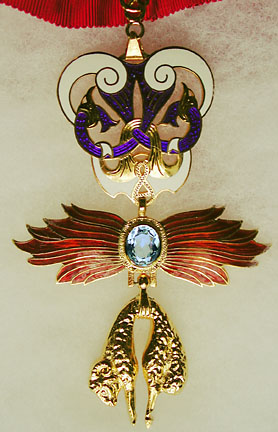
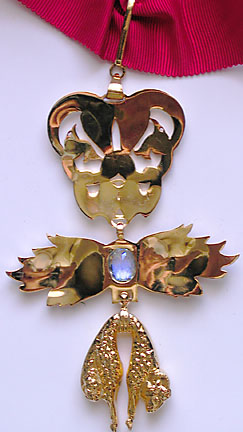 A
complete bijou of the Spanish Golden Fleece in silver-gilt fom the middle to
late period of Alphonso XIII, most likely 1900-1930 in date. Of the Spanish
Fleeces that we have seen this is one of the very finest, with high quality
workmanship, a creative design and a light blue sapphire in the Pierre a Fois.
The Fleece is in the Spanish profile manner and is in full round, but the other
elements are uniface as is normal with Spanish Fleece insignia. The briquette
is an elaborate Hispano-Moorish style of knotted “B”s with finely engraved edges,
and the flames are exceptionally modeled and complex for modern Spanish bijous.
The cut ball pivot for the Fleece hints at French workmanship, as does the Art
Nouveau briquette design. Contemporary and likely original cravat ribbon.
A
complete bijou of the Spanish Golden Fleece in silver-gilt fom the middle to
late period of Alphonso XIII, most likely 1900-1930 in date. Of the Spanish
Fleeces that we have seen this is one of the very finest, with high quality
workmanship, a creative design and a light blue sapphire in the Pierre a Fois.
The Fleece is in the Spanish profile manner and is in full round, but the other
elements are uniface as is normal with Spanish Fleece insignia. The briquette
is an elaborate Hispano-Moorish style of knotted “B”s with finely engraved edges,
and the flames are exceptionally modeled and complex for modern Spanish bijous.
The cut ball pivot for the Fleece hints at French workmanship, as does the Art
Nouveau briquette design. Contemporary and likely original cravat ribbon.
This is the second of such "standard" 20th century Spanish Fleece
bijous we have had. Unlike the first one which showed many marks of long wear,
this one seems immaculate and unworn and likely came from old dealer's stock.
The elements are a little smaller, and thus more "modern", in this
fleece than the previous one, giving it an elegant and decorative appearance.
When the number of Spanish members declined after the Civil War and was not
revived as a social order after the return of Juan Carlos, such speculative
manufactures remained unsold.
Until the last 10 years or so we saw several bijous of the Golden Fleece in
major dealers catalogs every year, but this is the first I have seen in a while.
More people, more money and no more ancient items being made is seeming to bring
scarcity to many antique objects from books to orders.
Immaculate condition.
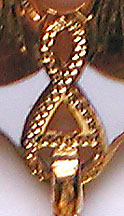 1,500
Euros ($2355). SOLD
1,500
Euros ($2355). SOLD
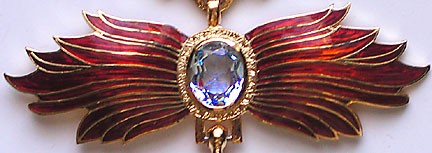
Court Badge of an Officer of the Spanish Inquisition
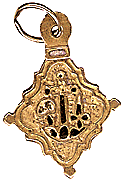 A very rare 18 k.
gold and enamel badge of office of the Royal Spanish Court Officer of the Spanish
Inquisition from c. 1700. This is the official whom Dostoyevsky would call the
"Grand Inquisitor". At this time the Grand Inquisitor was Balthasar
Sarmiento de Mendoza y Sandoval, 5th Marquis of Camarosa, Bishop of Segovia
and Knight of the Order of the Golden Fleece No. 476, and it is most likely
his badge. The badge is cut from a sheet of apx. 18 k. gold on an 18 k. gold
mounting ring, nearly worn through from wear. A significant portion of the original
enamels on the symbols remains.
A very rare 18 k.
gold and enamel badge of office of the Royal Spanish Court Officer of the Spanish
Inquisition from c. 1700. This is the official whom Dostoyevsky would call the
"Grand Inquisitor". At this time the Grand Inquisitor was Balthasar
Sarmiento de Mendoza y Sandoval, 5th Marquis of Camarosa, Bishop of Segovia
and Knight of the Order of the Golden Fleece No. 476, and it is most likely
his badge. The badge is cut from a sheet of apx. 18 k. gold on an 18 k. gold
mounting ring, nearly worn through from wear. A significant portion of the original
enamels on the symbols remains.
The date of the badge is very significant as 1700 was the year of the death
of Charles II, the last ruler from the medieval-leaning Habsburg dynasty. On
his death the War of the Spanish Succession followed with an Austrian-Habsburg
claimant opposing one from the French Bourbon dynasty. The Inquisition itself
was in some chaos at this time as well, with the Grand Inquisitor proposing
arresting Froilan Diaz, another member of the Suprema (Church Council of the
Spanish Holy Office). Balthazar was also a knight of the Golden Fleece (no.
476 from 1669 to his death in 1715).
Finally, the throne was awarded to the Bourbons, with the Habsburgs gaining
territories elsewhere and the right to have their own version of the prestigious
Order of the Golden Fleece. Alas, poor Balthazar backed the wrong candidate,
and we hear little from him in his last years. The Bourbons attempted to modernize
Spain in the manner of France, but the Spanish were attached to their ancient
and inefficient customs and change was slow. The Inquisition was a peculiarly
Spanish institution, and they clung to its repressive and backward looking isolationism.
Even when Napoleon eliminated it while his brother Joseph was King of Spain,
the Spanish Bourbon King Ferdinand brought it back again in 1815 and it endured
for a further generation.
A wonderful piece of history, it is 2.2 cm wide, 3 cm tall with an 8 mm mounting
ring and weighs apx. 5 grams. Comes with several pages of documentation and
history, including a German catalog page showing the piece, bill of sale from
a London auction showing it sold for $800 in 1988, a copy from Gottschalk's
history of ancient orders of 1818 showing the piece and notes on the career
of de Mendoza y Sandoval, Grand Inquisitor of the Holy Order and member of the
Order of the Golden Fleece. For more details see Inquisition
info
VF with some chips to the enameled and wear to the attachment point.
$1,000.00 SOLD
AUSTRIA-HUNGARY
Order of the Golden Fleece (Austrian)
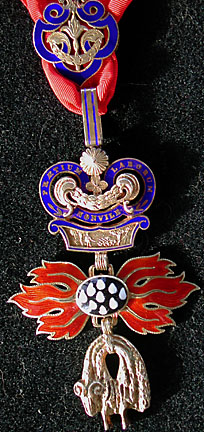 An Imperial Austrian
wearing bijou from c. 1900 in silver gilt. In very fine condition with a couple
enamel flakes and two very old repairs to the blue enamel on the reverse consistent
with long wearing of the bijou. Very scarce and important and seldom seen in commerce
compared to the much commoner Spanish Fleece. Complete with fleece, pierre a fois,
briquet, ribbon slide and an old neck ribbon with ties. Provenance known for over
40 years: ex Herold, ex Hawkes, ex Ostrom (1960s).
An Imperial Austrian
wearing bijou from c. 1900 in silver gilt. In very fine condition with a couple
enamel flakes and two very old repairs to the blue enamel on the reverse consistent
with long wearing of the bijou. Very scarce and important and seldom seen in commerce
compared to the much commoner Spanish Fleece. Complete with fleece, pierre a fois,
briquet, ribbon slide and an old neck ribbon with ties. Provenance known for over
40 years: ex Herold, ex Hawkes, ex Ostrom (1960s).
These were the kind of daily wearing fleeces that actually saw use. The heavier,
and much more valuable solid gold ones were usually reserved for special occassions.
As we can see from the well known collections of the Schwartzenbergs and Furstenburgs
they possessed many examples in their jewelry collections.
VF+ -- $3,200.00 SOLD
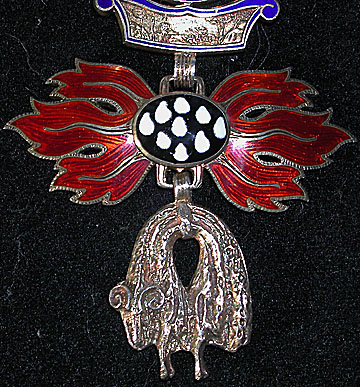
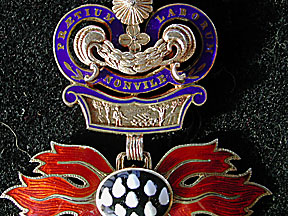
Order of the Golden Fleece (Austrian)
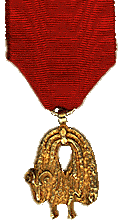 The Order of the Golden
Fleece is seldom met with in commerce. One of the more interesting varieties is
the so called "knopfloch" or "button-hole" Fleece. The Fleece
was in early times worn by itself on a ribbon, usually red but sometimes black
(Phillip II of Spain favored black ribbons). As the Fleece became larger and more
complex with the steel, touchstone and motto being added it became awkward to
wear in everyday usage. In Germany and France it became the habit to wear only
the Fleece on a red ribbon through a button hole, especially from the mid nineteenth
century on. Later a button was often sewn on the back of the ribbon to facilitate
wearing.
The Order of the Golden
Fleece is seldom met with in commerce. One of the more interesting varieties is
the so called "knopfloch" or "button-hole" Fleece. The Fleece
was in early times worn by itself on a ribbon, usually red but sometimes black
(Phillip II of Spain favored black ribbons). As the Fleece became larger and more
complex with the steel, touchstone and motto being added it became awkward to
wear in everyday usage. In Germany and France it became the habit to wear only
the Fleece on a red ribbon through a button hole, especially from the mid nineteenth
century on. Later a button was often sewn on the back of the ribbon to facilitate
wearing.
This example is silver gilt and is a correct and proper "final Austrian Fleece"
c. 1900-1918.
Reference: Steiner, o1.7.
EF
$950.00 SOLD
A second example. $850.00 SOLD
1813-1814 Canon Cross, Officer’s Gilt Version
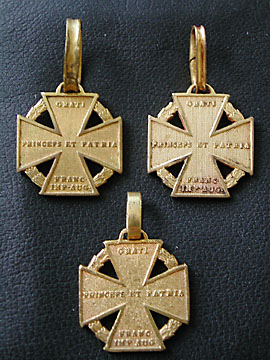 We are pleased
to have three variations of the scarce officer’s gilt 1813-1814 Canon
Cross from a famous collection. All are heavily gilt after removal of the original
green lacquer, and show slight wear from usage, although all are in overall
VF condition or better. All three bear the official double eagle in a diamond
hallmark. After 20 years of searching I now have found proper color and quality
replacement ribbons for all these crosses. No. 1, in the upper left, has a thick,
grooved issue-type ribbon ring; no. 2, in the upper right, has a thin, grooved
issue-type ribbon ring; and no. 3, at the bottom, has a replacement thick, gold
flat ribbon ring.
We are pleased
to have three variations of the scarce officer’s gilt 1813-1814 Canon
Cross from a famous collection. All are heavily gilt after removal of the original
green lacquer, and show slight wear from usage, although all are in overall
VF condition or better. All three bear the official double eagle in a diamond
hallmark. After 20 years of searching I now have found proper color and quality
replacement ribbons for all these crosses. No. 1, in the upper left, has a thick,
grooved issue-type ribbon ring; no. 2, in the upper right, has a thin, grooved
issue-type ribbon ring; and no. 3, at the bottom, has a replacement thick, gold
flat ribbon ring.
There were almost 300,000 common crosses made by several manufacturers, and
so the ribbon rings and hallmarks vary slightly as here, but likely only 2%
or so still survive today and this is an increasingly scarce item. Officer's
crosses in gilt likely only number a few hundred at most as I have only seen
or heard of less than a dozen in 30 years of looking.
Reference:
VF to EF
$425.00 each, with 6 inches of proper ribbon SOLD
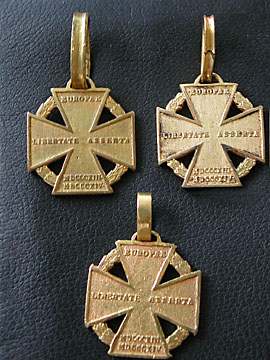
Prague Coronation Medal of Ferdinand I and Maria Anna Augusta, 1836
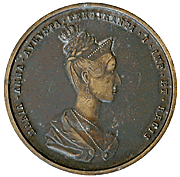 A commerative medal
celebrating the coronation of Empress Maria Anna Augusta and Emperor Ferdinand
I as queen and king of Bohemia in Prague in September 1836. Blackened bronze,
highlights polished brighter. Obverse inscribed: "MARIA . ANNA . AVGVSTA . FERDINANDI
. I . IMP . ET . REGIS", reverse: "GERMANY . ET . ALTERA . MIHI . PATRIA / CORON.PRAGAE.MENSE.SEPT.MCCCXXXVI(sic)"
with crown on cushion above Bohemian coat of arms.
A commerative medal
celebrating the coronation of Empress Maria Anna Augusta and Emperor Ferdinand
I as queen and king of Bohemia in Prague in September 1836. Blackened bronze,
highlights polished brighter. Obverse inscribed: "MARIA . ANNA . AVGVSTA . FERDINANDI
. I . IMP . ET . REGIS", reverse: "GERMANY . ET . ALTERA . MIHI . PATRIA / CORON.PRAGAE.MENSE.SEPT.MCCCXXXVI(sic)"
with crown on cushion above Bohemian coat of arms.
VF
$125.00 SOLD
The Apolostolic Order of St. Stephen of Hungary
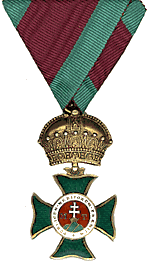 The Apostolic Order
of St. Stephen was founded by the Empress Maria Theresa on 5 May, 1764 to reward
civil merit by members of the Hungarian nobility with at least four quarterings
of nobility. It kept to its original purpose to the end of the Empire and is
the rarest of the great Austro-Hungarian orders since it never became a common
a reward for service. This particular silver gilt piece has magnificent and
lustrous enamel and exceptionally fine guillots engraved below the enamel making
it a production of a major jeweler. Undoubtedly a wearer's piece from the end
of the Empire.
The Apostolic Order
of St. Stephen was founded by the Empress Maria Theresa on 5 May, 1764 to reward
civil merit by members of the Hungarian nobility with at least four quarterings
of nobility. It kept to its original purpose to the end of the Empire and is
the rarest of the great Austro-Hungarian orders since it never became a common
a reward for service. This particular silver gilt piece has magnificent and
lustrous enamel and exceptionally fine guillots engraved below the enamel making
it a production of a major jeweler. Undoubtedly a wearer's piece from the end
of the Empire.
A Knight's Cross by a major jeweler from 1870-1918.
Reference: Steiner, o3.3c.
NEF -- $1,200.00 SOLD
Another Copy
The Apostolic Order of St. Stephen was founded by the Empress Maria Theresa
on 5 May, 1764 to reward civil merit by members of the Hungarian nobility with
at least four quarterings of nobility. It kept to its original purpose to the
end of the Empire and is the rarest of the great Austro-Hungarian orders since
it never became a common reward for service. Even the Golden Fleece, with only
50 members, is seen more frequently in commerce. This silver gilt piece has
magnificent and lustrous enamel and exceptionally fine guillots engraved below
the enamel making it a production of a major jeweler. An even finer piece than
that which we sold previously, and it has an Imperial era hallmark on the back
of the mounting clip. New ribbon with an old, bronze ribbon ring. The piece
has a fine patina of age on the crown while overall clean and bright.
(For enlarged photos go to St. Stephen Photos)
A Knight's Cross by a major jeweler from 1870-1918.
Reference: Steiner, o3.3c.; Spada (France, Russia, Austria) page 227 no.2
EF -- $1,800.00 SOLD
1813-14 “Canon Cross”
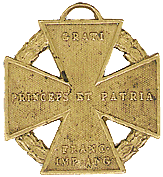 An example of this
important medal in very fine condition with little or no wear to the surface
or lettering. Lacking the issue green lacquer but showing remnants of an unofficial
and very old gilding. Possibly an officer's cross. Proper double eagle in a
diamond hallmark on the top of the strap for the ribbon ring. No ribbon or ribbon
ring, but these are often missing.
An example of this
important medal in very fine condition with little or no wear to the surface
or lettering. Lacking the issue green lacquer but showing remnants of an unofficial
and very old gilding. Possibly an officer's cross. Proper double eagle in a
diamond hallmark on the top of the strap for the ribbon ring. No ribbon or ribbon
ring, but these are often missing.
VF
$125.00 SOLD
1813-14 Officer's Gilt and Initialed “Canon Cross”
An officers gilt Canon Cross in good condition with the officers initials "L.M.
engraved in contemporary script on the bottom edge. A nice example of the very
scarce named officers crosses in a quaint variation. Proper double eagle in
a diamond hallmark on the top of the strap for the ribbon ring. No ribbon but
a fine, old decorative ribbon ring.
VF
$425.00 SOLD
Silver Medal for the Tyrolian Contingent, 1796
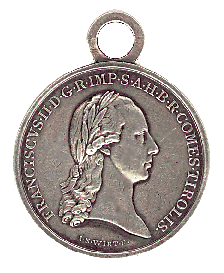
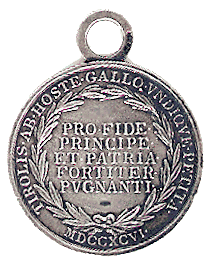 Facing
the danger posed by Napoleon's victories in Italy in 1796 the Austrian Emperor
took the daring step of authorizing the raising of militias for the defence
of the realm. Both the conservative Tyrol and Olmutz responded in 1796. This
medal was for all Tyrolian enlisted men who took up arms in the mobilization
call of 12 August 1796. Dies by Johann Wirt, then working in Paris. Much scarcer
than the 1797 Tyrolian medal when the mobilization was much larger. A fine piece
of 205 year-old history from the Napoleonic era.
Facing
the danger posed by Napoleon's victories in Italy in 1796 the Austrian Emperor
took the daring step of authorizing the raising of militias for the defence
of the realm. Both the conservative Tyrol and Olmutz responded in 1796. This
medal was for all Tyrolian enlisted men who took up arms in the mobilization
call of 12 August 1796. Dies by Johann Wirt, then working in Paris. Much scarcer
than the 1797 Tyrolian medal when the mobilization was much larger. A fine piece
of 205 year-old history from the Napoleonic era.
Reference: Heyden 994, VH&S 1099, Falkenstein pp. 31-2, Steiner e2.2 VF
No ribbon
$250.00 SOLD
Austrian order of the Iron Crown (OEK)
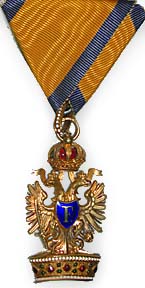 c. 1860-1880,
first version of the final type. Hallmarked gold by a major jeweler with early
style, original ribbon. The jewel-like luster of the enamels is exceptional.
Like new condition except for a slight discoloration on the back of the orb
in the eagle's left claw. Considered by many to be the most beautiful of all
European orders. Ex Gale Hawkes.
c. 1860-1880,
first version of the final type. Hallmarked gold by a major jeweler with early
style, original ribbon. The jewel-like luster of the enamels is exceptional.
Like new condition except for a slight discoloration on the back of the orb
in the eagle's left claw. Considered by many to be the most beautiful of all
European orders. Ex Gale Hawkes.
EF
$895.00 SOLD
Austrian Tyrol Service Medal
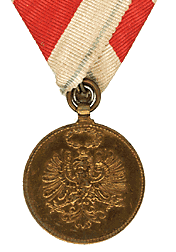 Awarded
to Walter Krüger of L.G.Bl. Nr. 28. Comes with original award document,
Nazi Abscrift permission to wear document (only the bottom shown) and two photos
(c. 1930) of Krüger and his unit in uniform. A fine WW I-Anschush Austrian
historic group.
Awarded
to Walter Krüger of L.G.Bl. Nr. 28. Comes with original award document,
Nazi Abscrift permission to wear document (only the bottom shown) and two photos
(c. 1930) of Krüger and his unit in uniform. A fine WW I-Anschush Austrian
historic group.
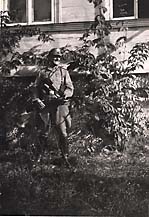
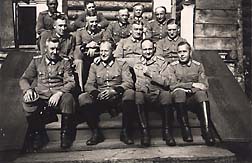
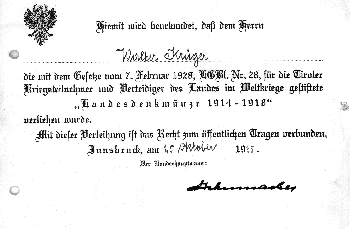
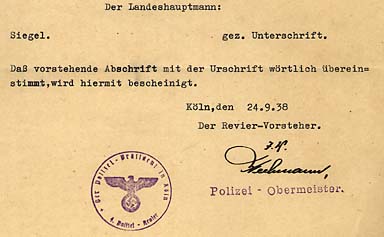
VF -- $75.00 SOLD
Bronze Gilt Signum Laudis & Silver Signum Laudis with Swords With Award
Documents.
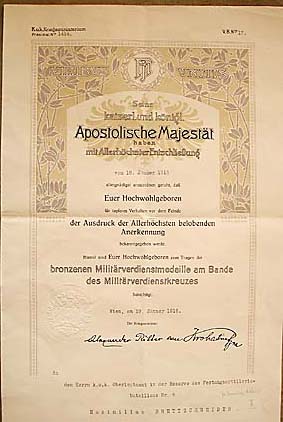
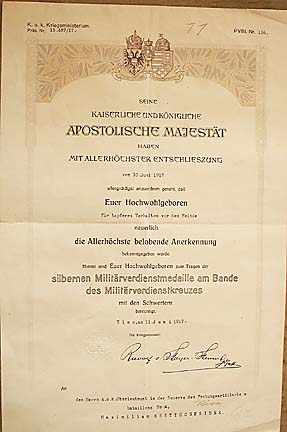 1.
A large and attractive award document to an Under-lieutenant of Garrison Artillery.
Issued in the name of Franz Joseph I and mentioning Austria only secondarily.
1.
A large and attractive award document to an Under-lieutenant of Garrison Artillery.
Issued in the name of Franz Joseph I and mentioning Austria only secondarily.
2. Award document to an Under-lieutenant of Garrison Artillery (same as Gilt
award above). Issued in the name of Austria-Hungary with Kaiser Karl graphically
and politically secondary. A most interesting change of national vision during
the war and a foretaste of separate national identities. It is also worthy of
note that despite two years separating the awards, and immense casualties to
the Austrian army, he is still only an Unter-lieutenant. Promotion, even in
the lower officer ranks, was class driven and not related to service or merit.
Pair of metals in VG+ condition with original ribbons and both award Documents.
$150.00 SOLD
Golden Jubilee Commemoration Medal
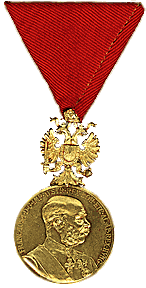 In commeration of
the fiftieth anniversary of his reign, Emperor Franz Joseph authorized this
medal for those who had completed 50 years duty in his service on or before
2 December 1898. A separately coined imperial eagle containing the suspension
is joined to the medal. The medal dies were cut by J. Tautenhayn, Jr., and this
medal exactly matches the official dies as used by Rothe of Vienna and so is
proper. As might be expected this medal is very rare since few people lived
to work for 50 years, and even fewer did so for the Emperor. Probably an everyday
“wearing” version.
In commeration of
the fiftieth anniversary of his reign, Emperor Franz Joseph authorized this
medal for those who had completed 50 years duty in his service on or before
2 December 1898. A separately coined imperial eagle containing the suspension
is joined to the medal. The medal dies were cut by J. Tautenhayn, Jr., and this
medal exactly matches the official dies as used by Rothe of Vienna and so is
proper. As might be expected this medal is very rare since few people lived
to work for 50 years, and even fewer did so for the Emperor. Probably an everyday
“wearing” version.
Reference: Heyden 1343, VH&S 1119, MI # 500, Falkenstein pp. 106-7, Steiner
e15.1
EF
$300.00 SOLD
Ischl
A magnificent leather portfolio commerating Franz Joseph's 50th year on the
throne issued by Bad Ischl, the small spa town where he spent all his summers.
It is on Japanese vellum, a bit brittle and with some edge damage, with several
etchings and color illuminations. It is signed by every member of the Ischl
town council. The leather is multicolored with a large, embossed copper ornament
on the cover. A magnificent presentation piece of surprisingly intimate character
for such an august and distant monarch.
$1,250.00 SOLD
GREAT BRITAIN
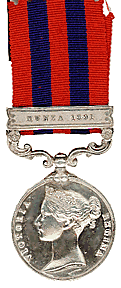
Indian General Service Medal -- 1854-95 with bar "Hunza"
To a sepoy in the 20th Punjab Infantry (only 32 Hunza bars to the regiment). The
Hunza bar was issued for service under Col. Durand against the Mir of Hunza for
his refusal to permit safe British passage through his territories. Col. Durand's
family was active in Imperial service, including demarcation of the "Durand Line"
separating British India from Afghanistan. The 20th Punjabis in this campaign
were the personal bodyguard of Col. Durand and served at the storming of the fort
at Nilt, where Durand was severely wounded and several VCs and DSOs were awarded.
No British units served in this campaign and the bar is very scarce.
EF (with only a few trivial polishing scratches)
$450.00 SOLD
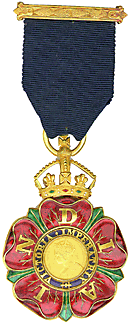
Companion of the Indian Empire -- First Issue
The first issue of the Order of the Indian Empire was issued, like the Star of
India, in one class only. The decoration is unique in its large size with unusually
deep and lustrous enamel and the word "INDIA" on the petals. Commemorates the
assumption by Queen Victoria of the title Empress of India. Issued for less than
two years when it was replaced by the second, smaller type in three classes. Complete
with gold top bar and original ribbon.
EF
$1,800.00 SOLD

Miniature of the Order of the Indian Empire -- Third Issue
An exceptionally fine miniature with very sharp detailing, marked 18K. Lacking
top bar but with old ribbon.
EF
$250.00 SOLD

Miniature of the Order of the Star of India
A very old miniature in gold, silver, enamel and cameo dating from the origins
of the order. Ex Joy Hawkes.
EF
$750.00 SOLD
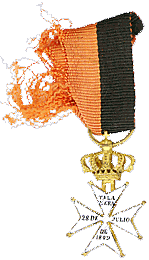
Miniature of the Talavera Cross
Issued by Spain to her officers, and possibly to some English officers as well,
for fighting at the victory of Talavera in 1809. The medal is very rare and only
a couple full size examples have been in commerce in the last 30 years. This is
the only miniature known in commerce in that period. Gold and enamels with original
ribbon. Ex Joy Hawkes.
VF
$500.00 SOLD


Miniature of the Jellalabad Winged Victory
The only miniature we have ever seen of the second medal for the defense of
Jellalabad during the First Afghan War. Contemporary and very fine except for
repaired suspension (no longer swivels). The British government issued this
medal when they decided that the original "Mural Crown" medal was
too inelegant and not classical enough for current British taste. Men were asked
to hand in their medals in exchange, and only a dozen or so did. Very rare in
any form.
VF
$550.00 SOLD
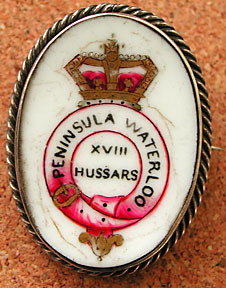 The
oldest and finest "sweetheart pin" we have ever seen. Not hallmarked
but a fine piece of silversmith's work from 1816-1818 in the typical Georgian
style. The 18th Hussars were at Waterloo, mentioned on the pin, and so it is
later than 1815, and the 18th was disbanded in 1818 which is the latest possible
date. Apx. 1.6" tall in silver and ivory with oil painted front in black,
rose and gold showing the regimental crown and garter badge with Peninsula and
Waterloo battle honors. The silver pin works well and the piece can be worn.
The 18th was stationed in the north of England and so it was likely made by
a provincial jeweler there. It is much more closely related to portrait miniatures
on ivory of the same period than to the private military medals of the era.
This is at least 100 years older than any other sweetheart pin we have seen,
and it is a most rare and unique Napoleonic antique. Ex Gale Hawkes.
The
oldest and finest "sweetheart pin" we have ever seen. Not hallmarked
but a fine piece of silversmith's work from 1816-1818 in the typical Georgian
style. The 18th Hussars were at Waterloo, mentioned on the pin, and so it is
later than 1815, and the 18th was disbanded in 1818 which is the latest possible
date. Apx. 1.6" tall in silver and ivory with oil painted front in black,
rose and gold showing the regimental crown and garter badge with Peninsula and
Waterloo battle honors. The silver pin works well and the piece can be worn.
The 18th was stationed in the north of England and so it was likely made by
a provincial jeweler there. It is much more closely related to portrait miniatures
on ivory of the same period than to the private military medals of the era.
This is at least 100 years older than any other sweetheart pin we have seen,
and it is a most rare and unique Napoleonic antique. Ex Gale Hawkes.
Comes with a list of the officers of the regiment at this time and some copies
of prints and descriptions of the regiment.
VF -- $1,200.00 SOLD
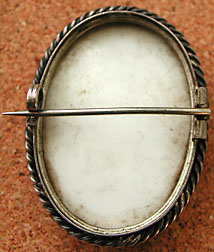
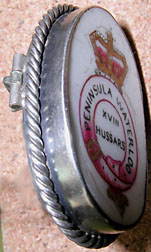
Admiral Vernon’s Medal for the Capture of Portobello in 1739
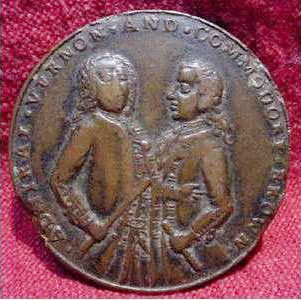
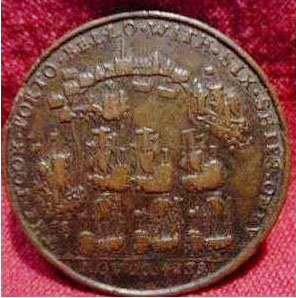
The pinchbeck metal medallion commenting the capture of Portobello in Panama
by Admiral Vernon and Commodore Brown in 1739. It is toned to a rich brown and
is in F-VF condition for its age and near as struck with only minor dings. A
scarce early military medallion and seldom seen. Similar to Mitchner 5047 and
37 mm in diameter. Historically this is a very interesting piece as it reflects
the continuing struggle between Spain and England over American trade. The more
general struggle of the War of the Austrian Succession will not break out until
the next year. Although sold as a commutative and not an official issue to combatants,
this is clearly a precursor to the numerous British campaign medals of the 19th
and 20th centuries.
F-VF -- $65.00 SOLD
SERBIA – JUGOSLAVIA
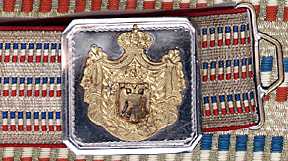
Jugoslavian Hussar Officer's Belt c. 1919-1940
A splendid hussar officer's belt in silver bullion and red, white and blue
silk. Red felt backing and gilt and chrome buckle plate. Dates from the inter-war
period of the Kingdom of Jugoslavia. Scarce and unusual and in very fine condition,
except for some staining to the gilt buckle plate that will clean off. $150.00
SOLD
FRANCE
Coronne de Fer – Napoleon’s Iron Crown of the Kingdom of Italy
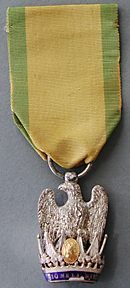
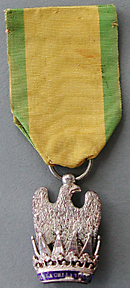 An
exceptional example of one of the rarest Napoleonic orders from the collection
of the noted Napoleonic collector Robert Florey. Napoleon established the Coronne
de Fer in 1805 for the Kingdom of Italy as the Italian equivalent to the Legion
of Honor. Napoleon only wore, and always wore, the first two orders he created
-- the Legion of Honor and the Coronne de Fer. Any serious Napoleonic collector
must have both and the Coronne is vastly more rare. There were some 40,000 First
Empire Legion of Honor awards and only around 500 Coronne de Fer, and a much
smaller percentage of Coronnes have survived. Most of the Italian insignia were
destroyed in exchange for Austrian Iron Crowns after the 1816 reorganization
of the Order. The Coronne was given so seldom that even Marshall Lannes, Napoleon's
closest friend, was only a knight, and not a dignitary, of the order. In the
last 20 years there have been many hundreds of First Empire Legion of Honor
pieces for sale, but less than a dozen Coronnes.
An
exceptional example of one of the rarest Napoleonic orders from the collection
of the noted Napoleonic collector Robert Florey. Napoleon established the Coronne
de Fer in 1805 for the Kingdom of Italy as the Italian equivalent to the Legion
of Honor. Napoleon only wore, and always wore, the first two orders he created
-- the Legion of Honor and the Coronne de Fer. Any serious Napoleonic collector
must have both and the Coronne is vastly more rare. There were some 40,000 First
Empire Legion of Honor awards and only around 500 Coronne de Fer, and a much
smaller percentage of Coronnes have survived. Most of the Italian insignia were
destroyed in exchange for Austrian Iron Crowns after the 1816 reorganization
of the Order. The Coronne was given so seldom that even Marshall Lannes, Napoleon's
closest friend, was only a knight, and not a dignitary, of the order. In the
last 20 years there have been many hundreds of First Empire Legion of Honor
pieces for sale, but less than a dozen Coronnes.
This example is a large, French-made bijou of true Imperial character. It has
a correct French First Empire period punched proof mark. The eagle is a magnificent
late Empire type of the 1812-1814 period with richly engraved feathers and high
rising wings. The gold medalion Napoleon-head is a right-facing variety (Type
II, 1st variety). Type II of 1809-1814 has balls on the tips of the crown to
reduce splitting of the enamel, and the motto is only in Italian (the very rare
Type I of 1805-1809 has no balls on the tips, and two basic varieties with the
motto in Italian or French depending on the nationality of the holder). The
motto is complete here and has only modest chipping to the bottom of the blue
band; the light blue enamel of the tips has faded with age and has some splits.
The ribbon is a very old Second Empire period ribbon and is in good condition,
but with normal overall fading. Old ribbons are very unusual with the Coronne
as they almost invariably have rotted away. (I have found no genuine French
First Empire ribbon in useable condition, and most are badly rotted and faded,
if not shreading.)
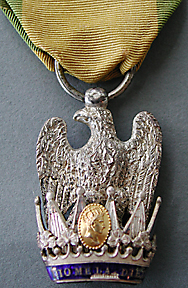 This
is one of three Coronnes that Robert Florey had in his collection that were
purchased from French dealers from the 1930s to the 1960s. Robert Florey was
the director of Flying Tigers, with John Wayne, and God Is My Co-Pilot
among some 56 movies. His Coronnes were sold from his estate by Gale Hawkes,
the noted dealer in medals and orders, around 1990, and then passed into a large
and important Washington State collection for many years. Such items are increasingly
rare and very seldom seen, especially with such provenance. Another, similar,
French-made Coronne was offered in 2004 by a noted British dealer for some 4200
Pounds.
This
is one of three Coronnes that Robert Florey had in his collection that were
purchased from French dealers from the 1930s to the 1960s. Robert Florey was
the director of Flying Tigers, with John Wayne, and God Is My Co-Pilot
among some 56 movies. His Coronnes were sold from his estate by Gale Hawkes,
the noted dealer in medals and orders, around 1990, and then passed into a large
and important Washington State collection for many years. Such items are increasingly
rare and very seldom seen, especially with such provenance. Another, similar,
French-made Coronne was offered in 2004 by a noted British dealer for some 4200
Pounds.
VF+ condition with original patina and old, Second Empire period ribbon.
Reference: Spada (France, Russia, Austria) page 57 no.1
$5,000.00 SOLD
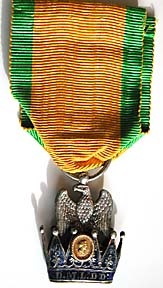
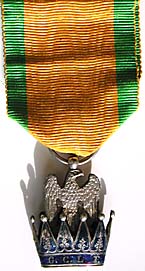
Coronne de Fer
A fine example of one of the rarest Napoleonic orders. Napoleon established the
Coronne de Fer in 1805 for the Kingdom of Italy as the Italian equivalent to the
Legion of Honor. Napoleon only wore, and always wore, the two orders he created
-- the Legion of Honor and the Coronne de Fer. Any serious Napoleonic collector
must have both and the Coronne is vastly more rare. There were some 40,000 1st
Empire Legion of Honor awards and less than 1,000 Coronne de Fer, and a much smaller
percentage of Coronnes have survived. They were given so seldom that even Marshall
Lannes, Napoleon's closest friend, was only a knight, and not a dignitary, of
the order. In the last 20 years there have been hundreds of 1st Empire Legion
of Honor pieces for sale, but only perhaps a dozen Coronnes.
This example is a very fine piece of undoubted authenticity, even having much
of the original blue enamel remaining (due to the narrow points it usually flakes
off). It is in the flat, coin-like Empire style and the French about 3/4 size
wearing type. Due to the slightly smaller size the motto is in initials only (I
have seen one other of this type). It is a second issue of 1807-1813 with balls
on the tips of the crown and only Italian motto (the first issue of 1805-06 had
no balls on the tips and either French or Italian motto).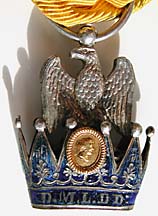
VF condition with original patina and modern ribbon.
Reference: Spada (France, Russia, Austria) page 57 no.1
$4,800.00 SOLD
1812 Knight’s Badge of the Legion of Honor by Biennais, 4th type with
3rd type crown.
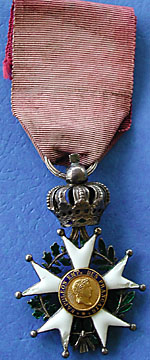 A Legion
of Honor that is unusual in that it can be both be identified to maker and relatively
precisiely dated. Of all the order makers Biennais, jeweler to Napoleon, used
a cross patee or maltese cross on the top rather than the latin cross. The crown
shows decorative elements of the late 3rd type of Legion of Honor but the badge
is 4th type with balls on the ends of the points (to prevent enamel chips, but
not entirely successfully). This would date its manufacture to December 1812
after Napoleon’s return to Paris following the Russian disaster. There
were few Legion badges made while the Russian invasion was in progress, but
a large number were dispensed when Napoleon returned briefly in December to
reorganize the government and suppress discontent and plots.
A Legion
of Honor that is unusual in that it can be both be identified to maker and relatively
precisiely dated. Of all the order makers Biennais, jeweler to Napoleon, used
a cross patee or maltese cross on the top rather than the latin cross. The crown
shows decorative elements of the late 3rd type of Legion of Honor but the badge
is 4th type with balls on the ends of the points (to prevent enamel chips, but
not entirely successfully). This would date its manufacture to December 1812
after Napoleon’s return to Paris following the Russian disaster. There
were few Legion badges made while the Russian invasion was in progress, but
a large number were dispensed when Napoleon returned briefly in December to
reorganize the government and suppress discontent and plots.
There is the unsual enamel splitting to the tips of the arms and contact chipping
to the blue background of the motto on the reverse, but overall a very fine
piece. A plus is the very old and possibly original, ribbon. It is older appearing
than any of the hundreds of ribbons we have seen on First Empire Legions of
Honor, and is dyed with the old vegetable dyes.
$1,250.00 SOLD
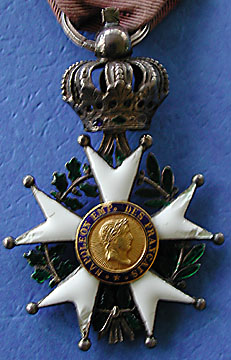
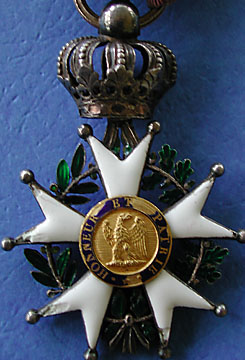
Order of the Reunion
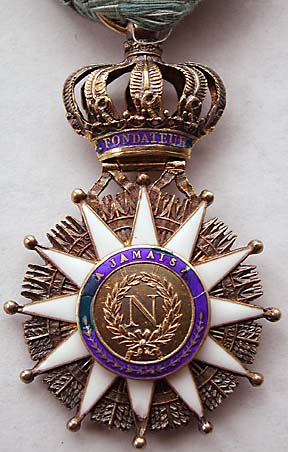 Transitory
and one of the scarcest Napoleonic items. Intended to replace a wide range of
orders in the Netherlands and Germany, it was only issued for some five years
before becoming obselete. There were around 1,400 awards made in three classes,
of which this is an example of the Knights award. Some one third of the awards
were to Frenchmen, and the majority were to Dutch citizens. With the first abdication
of Napoleon it was no longer permitted to wear the badge itself, but the ribbon
or sash could be worn. After the 100 days its use was entirely forbidden.
Transitory
and one of the scarcest Napoleonic items. Intended to replace a wide range of
orders in the Netherlands and Germany, it was only issued for some five years
before becoming obselete. There were around 1,400 awards made in three classes,
of which this is an example of the Knights award. Some one third of the awards
were to Frenchmen, and the majority were to Dutch citizens. With the first abdication
of Napoleon it was no longer permitted to wear the badge itself, but the ribbon
or sash could be worn. After the 100 days its use was entirely forbidden.
This example is of silver gilt and was clearly a daily wearing copy, still retaining
what appears to be the original, light blue silk ribbon. Although crisp and
in a good state of preservation, there is wear to the gilding, especially on
the back where it would rub against clothing. There is some of the usual enamel
splits that are shared by the Legion of Honor as well with its narrow points.
VF, except for some loss of gilding, with worn original ribbon
$1,500 SOLD
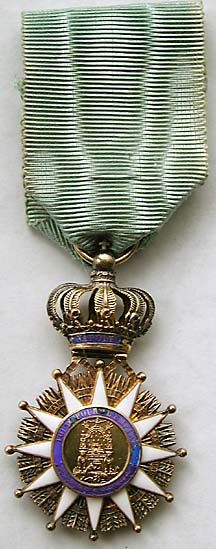
UNITED STATES
United States Miniature of the Army Congressional Medal of Honor

 The
only Medal of Honor it is legal to own unless it was awarded to you. In the
U.S. miniatures are allowed for mess dress with the exception of the Medal of
Honor, which always must be worn full size around the neck. A fine quality miniature
MOH was produced after the Spanish American War in some 100 copies, but it was
rejected by the U.S. military and these are seldom seen. Some few private miniatures
have been made since of which this is one. This miniature seems to be a post
WW II copy as it has a clutch back, and it clearly has seen much wear with some
enamel chips and one clutch pin broken off. There were many MOHs awarded in
WW II, so it seems the most likely period. The exact date is uncertain, however,
with one expert thinking it pre WW II and another perhaps Viet Nam era. Very
scarce and desirable whatever period it represents and almost certainly worn
by a MOH recipient.
The
only Medal of Honor it is legal to own unless it was awarded to you. In the
U.S. miniatures are allowed for mess dress with the exception of the Medal of
Honor, which always must be worn full size around the neck. A fine quality miniature
MOH was produced after the Spanish American War in some 100 copies, but it was
rejected by the U.S. military and these are seldom seen. Some few private miniatures
have been made since of which this is one. This miniature seems to be a post
WW II copy as it has a clutch back, and it clearly has seen much wear with some
enamel chips and one clutch pin broken off. There were many MOHs awarded in
WW II, so it seems the most likely period. The exact date is uncertain, however,
with one expert thinking it pre WW II and another perhaps Viet Nam era. Very
scarce and desirable whatever period it represents and almost certainly worn
by a MOH recipient.
In the 1990s the U.S. government responded to the growing number of reproduction
MOHs, and the buying and selling of the nation’s highest decoration, by
making it illegal to own, buy or sell a MOH. Only holders of the decoration
or their heirs could legally possess the piece. Several MOHs being offered or
advertised in violation of this law were siezed, but as the miniature is completely
unofficial it is exempt from this regulation.
Provenance: from a major German dealer.
$250.00 SOLD
For orders, questions or suggestions please contact Stephen
Herold.
Sales by check, money order or major credit cards.
Stephen Herold
4262 Fremont Avenue North
Seattle, Wa 98103, USA
206-547-1718 (11-6 PST, M-F)
GO TO:
Medals & Orders
Stephen Herold's Home Page
Society of the Golden Fleece
The Société Napoléonienne
Antiques AtoZ Home Page
Books AtoZ Home Page
This site copyright ©Antiques AtoZ 1996-2002. All rights reserved.
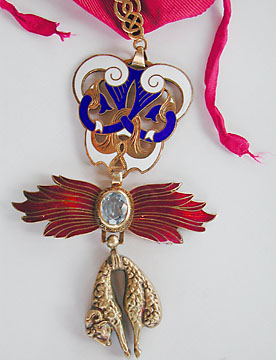 A
complete bijou of the Spanish Golden Fleece in silver-gilt fom the middle to
late period of Alphonso XIII, most likely 1900-1930 in date. Of the Spanish
Fleeces that we have seen this is one of the very finest, with high quality
workmanship, a creative design and a light blue sapphire in the Pierre a Fois.
The Fleece is in the Spanish profile manner and is in full round, but the other
elements are uniface as is normal with Spanish Fleece insignia. The briquette
is an elaborate Hispano-Moorish style of knotted “B”s with finely
engraved edges, and the flames are exceptionally modeled and complex for modern
Spanish bijous. The cut ball pivot for the Fleece hints at French workmanship,
as does the Art Nouveau briquette design. Contemporary and likely original cravat
ribbon.
A
complete bijou of the Spanish Golden Fleece in silver-gilt fom the middle to
late period of Alphonso XIII, most likely 1900-1930 in date. Of the Spanish
Fleeces that we have seen this is one of the very finest, with high quality
workmanship, a creative design and a light blue sapphire in the Pierre a Fois.
The Fleece is in the Spanish profile manner and is in full round, but the other
elements are uniface as is normal with Spanish Fleece insignia. The briquette
is an elaborate Hispano-Moorish style of knotted “B”s with finely
engraved edges, and the flames are exceptionally modeled and complex for modern
Spanish bijous. The cut ball pivot for the Fleece hints at French workmanship,
as does the Art Nouveau briquette design. Contemporary and likely original cravat
ribbon. 
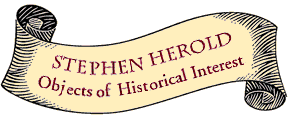
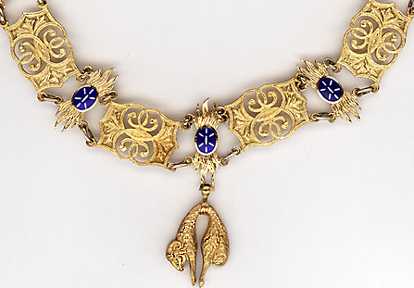
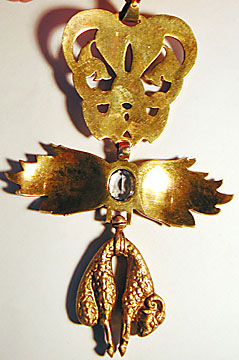 From a noted American collection with 40 years of provenance through four owners.
No hallmarks, as is usual in Spanish jewelry of this period.
From a noted American collection with 40 years of provenance through four owners.
No hallmarks, as is usual in Spanish jewelry of this period.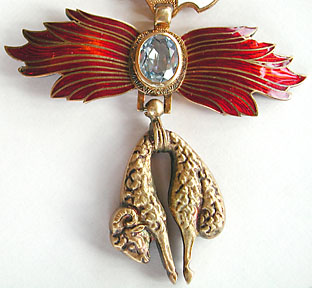
 A very rare 18 k.
gold and enamel badge of office of the Royal Spanish Court Officer of the Spanish
Inquisition from c. 1700. This is the official whom Dostoyevsky would call the
"Grand Inquisitor". At this time the Grand Inquisitor was Balthasar
Sarmiento de Mendoza y Sandoval, 5th Marquis of Camarosa, Bishop of Segovia
and Knight of the Order of the Golden Fleece No. 476, and it is most likely
his badge. The badge is cut from a sheet of apx. 18 k. gold on an 18 k. gold
mounting ring, nearly worn through from wear. A significant portion of the original
enamels on the symbols remains.
A very rare 18 k.
gold and enamel badge of office of the Royal Spanish Court Officer of the Spanish
Inquisition from c. 1700. This is the official whom Dostoyevsky would call the
"Grand Inquisitor". At this time the Grand Inquisitor was Balthasar
Sarmiento de Mendoza y Sandoval, 5th Marquis of Camarosa, Bishop of Segovia
and Knight of the Order of the Golden Fleece No. 476, and it is most likely
his badge. The badge is cut from a sheet of apx. 18 k. gold on an 18 k. gold
mounting ring, nearly worn through from wear. A significant portion of the original
enamels on the symbols remains. An Imperial Austrian
wearing bijou from c. 1900 in silver gilt. In very fine condition with a couple
enamel flakes and two very old repairs to the blue enamel on the reverse consistent
with long wearing of the bijou. Very scarce and important and seldom seen in commerce
compared to the much commoner Spanish Fleece. Complete with fleece, pierre a fois,
briquet, ribbon slide and an old neck ribbon with ties. Provenance known for over
40 years: ex Herold, ex Hawkes, ex Ostrom (1960s).
An Imperial Austrian
wearing bijou from c. 1900 in silver gilt. In very fine condition with a couple
enamel flakes and two very old repairs to the blue enamel on the reverse consistent
with long wearing of the bijou. Very scarce and important and seldom seen in commerce
compared to the much commoner Spanish Fleece. Complete with fleece, pierre a fois,
briquet, ribbon slide and an old neck ribbon with ties. Provenance known for over
40 years: ex Herold, ex Hawkes, ex Ostrom (1960s).


 The Order of the Golden
Fleece is seldom met with in commerce. One of the more interesting varieties is
the so called "knopfloch" or "button-hole" Fleece. The Fleece
was in early times worn by itself on a ribbon, usually red but sometimes black
(Phillip II of Spain favored black ribbons). As the Fleece became larger and more
complex with the steel, touchstone and motto being added it became awkward to
wear in everyday usage. In Germany and France it became the habit to wear only
the Fleece on a red ribbon through a button hole, especially from the mid nineteenth
century on. Later a button was often sewn on the back of the ribbon to facilitate
wearing.
The Order of the Golden
Fleece is seldom met with in commerce. One of the more interesting varieties is
the so called "knopfloch" or "button-hole" Fleece. The Fleece
was in early times worn by itself on a ribbon, usually red but sometimes black
(Phillip II of Spain favored black ribbons). As the Fleece became larger and more
complex with the steel, touchstone and motto being added it became awkward to
wear in everyday usage. In Germany and France it became the habit to wear only
the Fleece on a red ribbon through a button hole, especially from the mid nineteenth
century on. Later a button was often sewn on the back of the ribbon to facilitate
wearing.  We are pleased
to have three variations of the scarce officer’s gilt 1813-1814 Canon
Cross from a famous collection. All are heavily gilt after removal of the original
green lacquer, and show slight wear from usage, although all are in overall
VF condition or better. All three bear the official double eagle in a diamond
hallmark. After 20 years of searching I now have found proper color and quality
replacement ribbons for all these crosses. No. 1, in the upper left, has a thick,
grooved issue-type ribbon ring; no. 2, in the upper right, has a thin, grooved
issue-type ribbon ring; and no. 3, at the bottom, has a replacement thick, gold
flat ribbon ring.
We are pleased
to have three variations of the scarce officer’s gilt 1813-1814 Canon
Cross from a famous collection. All are heavily gilt after removal of the original
green lacquer, and show slight wear from usage, although all are in overall
VF condition or better. All three bear the official double eagle in a diamond
hallmark. After 20 years of searching I now have found proper color and quality
replacement ribbons for all these crosses. No. 1, in the upper left, has a thick,
grooved issue-type ribbon ring; no. 2, in the upper right, has a thin, grooved
issue-type ribbon ring; and no. 3, at the bottom, has a replacement thick, gold
flat ribbon ring. 
 A commerative medal
celebrating the coronation of Empress Maria Anna Augusta and Emperor Ferdinand
I as queen and king of Bohemia in Prague in September 1836. Blackened bronze,
highlights polished brighter. Obverse inscribed: "MARIA . ANNA . AVGVSTA . FERDINANDI
. I . IMP . ET . REGIS", reverse: "GERMANY . ET . ALTERA . MIHI . PATRIA / CORON.PRAGAE.MENSE.SEPT.MCCCXXXVI(sic)"
with crown on cushion above Bohemian coat of arms.
A commerative medal
celebrating the coronation of Empress Maria Anna Augusta and Emperor Ferdinand
I as queen and king of Bohemia in Prague in September 1836. Blackened bronze,
highlights polished brighter. Obverse inscribed: "MARIA . ANNA . AVGVSTA . FERDINANDI
. I . IMP . ET . REGIS", reverse: "GERMANY . ET . ALTERA . MIHI . PATRIA / CORON.PRAGAE.MENSE.SEPT.MCCCXXXVI(sic)"
with crown on cushion above Bohemian coat of arms. The Apostolic Order
of St. Stephen was founded by the Empress Maria Theresa on 5 May, 1764 to reward
civil merit by members of the Hungarian nobility with at least four quarterings
of nobility. It kept to its original purpose to the end of the Empire and is
the rarest of the great Austro-Hungarian orders since it never became a common
a reward for service. This particular silver gilt piece has magnificent and
lustrous enamel and exceptionally fine guillots engraved below the enamel making
it a production of a major jeweler. Undoubtedly a wearer's piece from the end
of the Empire.
The Apostolic Order
of St. Stephen was founded by the Empress Maria Theresa on 5 May, 1764 to reward
civil merit by members of the Hungarian nobility with at least four quarterings
of nobility. It kept to its original purpose to the end of the Empire and is
the rarest of the great Austro-Hungarian orders since it never became a common
a reward for service. This particular silver gilt piece has magnificent and
lustrous enamel and exceptionally fine guillots engraved below the enamel making
it a production of a major jeweler. Undoubtedly a wearer's piece from the end
of the Empire. An example of this
important medal in very fine condition with little or no wear to the surface
or lettering. Lacking the issue green lacquer but showing remnants of an unofficial
and very old gilding. Possibly an officer's cross. Proper double eagle in a
diamond hallmark on the top of the strap for the ribbon ring. No ribbon or ribbon
ring, but these are often missing.
An example of this
important medal in very fine condition with little or no wear to the surface
or lettering. Lacking the issue green lacquer but showing remnants of an unofficial
and very old gilding. Possibly an officer's cross. Proper double eagle in a
diamond hallmark on the top of the strap for the ribbon ring. No ribbon or ribbon
ring, but these are often missing.
 Facing
the danger posed by Napoleon's victories in Italy in 1796 the Austrian Emperor
took the daring step of authorizing the raising of militias for the defence
of the realm. Both the conservative Tyrol and Olmutz responded in 1796. This
medal was for all Tyrolian enlisted men who took up arms in the mobilization
call of 12 August 1796. Dies by Johann Wirt, then working in Paris. Much scarcer
than the 1797 Tyrolian medal when the mobilization was much larger. A fine piece
of 205 year-old history from the Napoleonic era.
Facing
the danger posed by Napoleon's victories in Italy in 1796 the Austrian Emperor
took the daring step of authorizing the raising of militias for the defence
of the realm. Both the conservative Tyrol and Olmutz responded in 1796. This
medal was for all Tyrolian enlisted men who took up arms in the mobilization
call of 12 August 1796. Dies by Johann Wirt, then working in Paris. Much scarcer
than the 1797 Tyrolian medal when the mobilization was much larger. A fine piece
of 205 year-old history from the Napoleonic era. c. 1860-1880,
first version of the final type. Hallmarked gold by a major jeweler with early
style, original ribbon. The jewel-like luster of the enamels is exceptional.
Like new condition except for a slight discoloration on the back of the orb
in the eagle's left claw. Considered by many to be the most beautiful of all
European orders. Ex Gale Hawkes.
c. 1860-1880,
first version of the final type. Hallmarked gold by a major jeweler with early
style, original ribbon. The jewel-like luster of the enamels is exceptional.
Like new condition except for a slight discoloration on the back of the orb
in the eagle's left claw. Considered by many to be the most beautiful of all
European orders. Ex Gale Hawkes. Awarded
to Walter Krüger of L.G.Bl. Nr. 28. Comes with original award document,
Nazi Abscrift permission to wear document (only the bottom shown) and two photos
(c. 1930) of Krüger and his unit in uniform. A fine WW I-Anschush Austrian
historic group.
Awarded
to Walter Krüger of L.G.Bl. Nr. 28. Comes with original award document,
Nazi Abscrift permission to wear document (only the bottom shown) and two photos
(c. 1930) of Krüger and his unit in uniform. A fine WW I-Anschush Austrian
historic group.



 In commeration of
the fiftieth anniversary of his reign, Emperor Franz Joseph authorized this
medal for those who had completed 50 years duty in his service on or before
2 December 1898. A separately coined imperial eagle containing the suspension
is joined to the medal. The medal dies were cut by J. Tautenhayn, Jr., and this
medal exactly matches the official dies as used by Rothe of Vienna and so is
proper. As might be expected this medal is very rare since few people lived
to work for 50 years, and even fewer did so for the Emperor. Probably an everyday
“wearing” version.
In commeration of
the fiftieth anniversary of his reign, Emperor Franz Joseph authorized this
medal for those who had completed 50 years duty in his service on or before
2 December 1898. A separately coined imperial eagle containing the suspension
is joined to the medal. The medal dies were cut by J. Tautenhayn, Jr., and this
medal exactly matches the official dies as used by Rothe of Vienna and so is
proper. As might be expected this medal is very rare since few people lived
to work for 50 years, and even fewer did so for the Emperor. Probably an everyday
“wearing” version.






 The
oldest and finest "sweetheart pin" we have ever seen. Not hallmarked
but a fine piece of silversmith's work from 1816-1818 in the typical Georgian
style. The 18th Hussars were at Waterloo, mentioned on the pin, and so it is
later than 1815, and the 18th was disbanded in 1818 which is the latest possible
date. Apx. 1.6" tall in silver and ivory with oil painted front in black,
rose and gold showing the regimental crown and garter badge with Peninsula and
Waterloo battle honors. The silver pin works well and the piece can be worn.
The 18th was stationed in the north of England and so it was likely made by
a provincial jeweler there. It is much more closely related to portrait miniatures
on ivory of the same period than to the private military medals of the era.
This is at least 100 years older than any other sweetheart pin we have seen,
and it is a most rare and unique Napoleonic antique. Ex Gale Hawkes.
The
oldest and finest "sweetheart pin" we have ever seen. Not hallmarked
but a fine piece of silversmith's work from 1816-1818 in the typical Georgian
style. The 18th Hussars were at Waterloo, mentioned on the pin, and so it is
later than 1815, and the 18th was disbanded in 1818 which is the latest possible
date. Apx. 1.6" tall in silver and ivory with oil painted front in black,
rose and gold showing the regimental crown and garter badge with Peninsula and
Waterloo battle honors. The silver pin works well and the piece can be worn.
The 18th was stationed in the north of England and so it was likely made by
a provincial jeweler there. It is much more closely related to portrait miniatures
on ivory of the same period than to the private military medals of the era.
This is at least 100 years older than any other sweetheart pin we have seen,
and it is a most rare and unique Napoleonic antique. Ex Gale Hawkes.





 An
exceptional example of one of the rarest Napoleonic orders from the collection
of the noted Napoleonic collector Robert Florey. Napoleon established the Coronne
de Fer in 1805 for the Kingdom of Italy as the Italian equivalent to the Legion
of Honor. Napoleon only wore, and always wore, the first two orders he created
-- the Legion of Honor and the Coronne de Fer. Any serious Napoleonic collector
must have both and the Coronne is vastly more rare. There were some 40,000 First
Empire Legion of Honor awards and only around 500 Coronne de Fer, and a much
smaller percentage of Coronnes have survived. Most of the Italian insignia were
destroyed in exchange for Austrian Iron Crowns after the 1816 reorganization
of the Order. The Coronne was given so seldom that even Marshall Lannes, Napoleon's
closest friend, was only a knight, and not a dignitary, of the order. In the
last 20 years there have been many hundreds of First Empire Legion of Honor
pieces for sale, but less than a dozen Coronnes.
An
exceptional example of one of the rarest Napoleonic orders from the collection
of the noted Napoleonic collector Robert Florey. Napoleon established the Coronne
de Fer in 1805 for the Kingdom of Italy as the Italian equivalent to the Legion
of Honor. Napoleon only wore, and always wore, the first two orders he created
-- the Legion of Honor and the Coronne de Fer. Any serious Napoleonic collector
must have both and the Coronne is vastly more rare. There were some 40,000 First
Empire Legion of Honor awards and only around 500 Coronne de Fer, and a much
smaller percentage of Coronnes have survived. Most of the Italian insignia were
destroyed in exchange for Austrian Iron Crowns after the 1816 reorganization
of the Order. The Coronne was given so seldom that even Marshall Lannes, Napoleon's
closest friend, was only a knight, and not a dignitary, of the order. In the
last 20 years there have been many hundreds of First Empire Legion of Honor
pieces for sale, but less than a dozen Coronnes. This
is one of three Coronnes that Robert Florey had in his collection that were
purchased from French dealers from the 1930s to the 1960s. Robert Florey was
the director of Flying Tigers, with John Wayne, and God Is My Co-Pilot
among some 56 movies. His Coronnes were sold from his estate by Gale Hawkes,
the noted dealer in medals and orders, around 1990, and then passed into a large
and important Washington State collection for many years. Such items are increasingly
rare and very seldom seen, especially with such provenance. Another, similar,
French-made Coronne was offered in 2004 by a noted British dealer for some 4200
Pounds.
This
is one of three Coronnes that Robert Florey had in his collection that were
purchased from French dealers from the 1930s to the 1960s. Robert Florey was
the director of Flying Tigers, with John Wayne, and God Is My Co-Pilot
among some 56 movies. His Coronnes were sold from his estate by Gale Hawkes,
the noted dealer in medals and orders, around 1990, and then passed into a large
and important Washington State collection for many years. Such items are increasingly
rare and very seldom seen, especially with such provenance. Another, similar,
French-made Coronne was offered in 2004 by a noted British dealer for some 4200
Pounds.


 A Legion
of Honor that is unusual in that it can be both be identified to maker and relatively
precisiely dated. Of all the order makers Biennais, jeweler to Napoleon, used
a cross patee or maltese cross on the top rather than the latin cross. The crown
shows decorative elements of the late 3rd type of Legion of Honor but the badge
is 4th type with balls on the ends of the points (to prevent enamel chips, but
not entirely successfully). This would date its manufacture to December 1812
after Napoleon’s return to Paris following the Russian disaster. There
were few Legion badges made while the Russian invasion was in progress, but
a large number were dispensed when Napoleon returned briefly in December to
reorganize the government and suppress discontent and plots.
A Legion
of Honor that is unusual in that it can be both be identified to maker and relatively
precisiely dated. Of all the order makers Biennais, jeweler to Napoleon, used
a cross patee or maltese cross on the top rather than the latin cross. The crown
shows decorative elements of the late 3rd type of Legion of Honor but the badge
is 4th type with balls on the ends of the points (to prevent enamel chips, but
not entirely successfully). This would date its manufacture to December 1812
after Napoleon’s return to Paris following the Russian disaster. There
were few Legion badges made while the Russian invasion was in progress, but
a large number were dispensed when Napoleon returned briefly in December to
reorganize the government and suppress discontent and plots.


 The
only Medal of Honor it is legal to own unless it was awarded to you. In the
U.S. miniatures are allowed for mess dress with the exception of the Medal of
Honor, which always must be worn full size around the neck. A fine quality miniature
MOH was produced after the Spanish American War in some 100 copies, but it was
rejected by the U.S. military and these are seldom seen. Some few private miniatures
have been made since of which this is one. This miniature seems to be a post
WW II copy as it has a clutch back, and it clearly has seen much wear with some
enamel chips and one clutch pin broken off. There were many MOHs awarded in
WW II, so it seems the most likely period. The exact date is uncertain, however,
with one expert thinking it pre WW II and another perhaps Viet Nam era. Very
scarce and desirable whatever period it represents and almost certainly worn
by a MOH recipient.
The
only Medal of Honor it is legal to own unless it was awarded to you. In the
U.S. miniatures are allowed for mess dress with the exception of the Medal of
Honor, which always must be worn full size around the neck. A fine quality miniature
MOH was produced after the Spanish American War in some 100 copies, but it was
rejected by the U.S. military and these are seldom seen. Some few private miniatures
have been made since of which this is one. This miniature seems to be a post
WW II copy as it has a clutch back, and it clearly has seen much wear with some
enamel chips and one clutch pin broken off. There were many MOHs awarded in
WW II, so it seems the most likely period. The exact date is uncertain, however,
with one expert thinking it pre WW II and another perhaps Viet Nam era. Very
scarce and desirable whatever period it represents and almost certainly worn
by a MOH recipient.